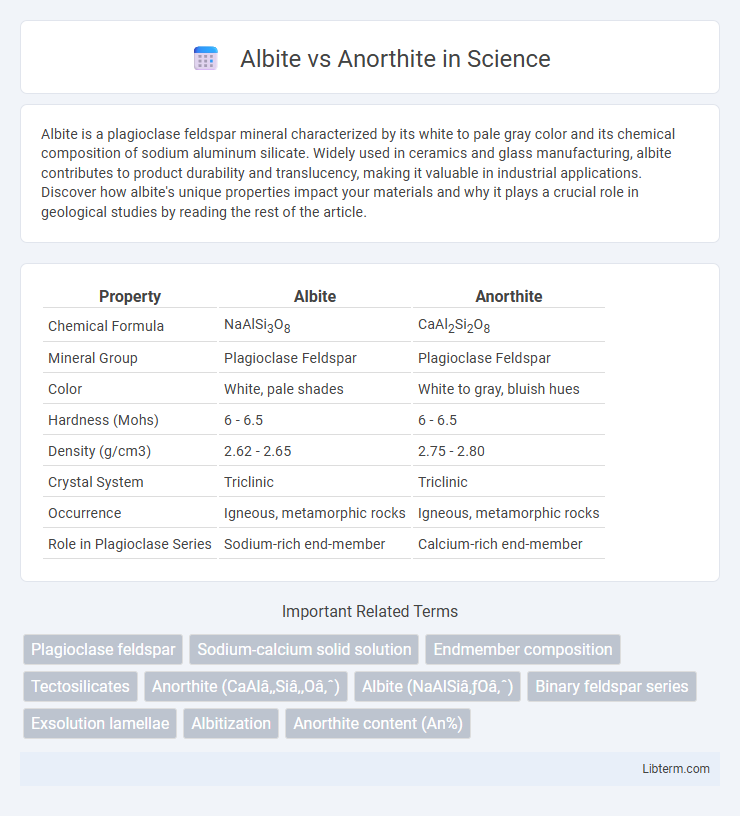Albite is a plagioclase feldspar mineral characterized by its white to pale gray color and its chemical composition of sodium aluminum silicate. Widely used in ceramics and glass manufacturing, albite contributes to product durability and translucency, making it valuable in industrial applications. Discover how albite's unique properties impact your materials and why it plays a crucial role in geological studies by reading the rest of the article.
Table of Comparison
| Property | Albite | Anorthite |
|---|---|---|
| Chemical Formula | NaAlSi3O8 | CaAl2Si2O8 |
| Mineral Group | Plagioclase Feldspar | Plagioclase Feldspar |
| Color | White, pale shades | White to gray, bluish hues |
| Hardness (Mohs) | 6 - 6.5 | 6 - 6.5 |
| Density (g/cm3) | 2.62 - 2.65 | 2.75 - 2.80 |
| Crystal System | Triclinic | Triclinic |
| Occurrence | Igneous, metamorphic rocks | Igneous, metamorphic rocks |
| Role in Plagioclase Series | Sodium-rich end-member | Calcium-rich end-member |
Introduction to Albite and Anorthite
Albite and anorthite are both members of the plagioclase feldspar mineral series, distinguished by their chemical composition. Albite is a sodium-rich feldspar with the formula NaAlSi3O8, while anorthite is calcium-rich, represented by CaAl2Si2O8. These minerals play crucial roles in igneous rock formation and serve as important indicators in petrology and geochemistry.
Chemical Composition Differences
Albite and anorthite are feldspar minerals distinguished primarily by their chemical compositions, with albite being sodium-rich (NaAlSi3O8) and anorthite calcium-rich (CaAl2Si2O8). Albite contains sodium ions substituting for calcium in the crystal lattice, resulting in a higher silica content compared to anorthite. The compositional variation between these minerals reflects a solid solution series between NaAlSi3O8 and CaAl2Si2O8, crucial for understanding their formation conditions in igneous and metamorphic rocks.
Crystal Structure Comparison
Albite and anorthite are both members of the plagioclase feldspar series with distinct crystal structures defined by their varying sodium and calcium content. Albite, rich in sodium (NaAlSi3O8), crystallizes in the triclinic system with a lower symmetry compared to anorthite, which is calcium-rich (CaAl2Si2O8) and also triclinic but exhibits slightly different lattice parameters due to the larger calcium ions. This compositional variation influences their unit cell dimensions and results in subtle differences in cleavage, refractive indices, and overall crystal morphology.
Physical Properties: Color, Hardness, and Luster
Albite typically exhibits a white to pale gray color, with a Mohs hardness of about 6 to 6.5 and a vitreous to pearly luster, making it relatively durable and visually glossy. Anorthite, in contrast, often presents a white, gray, or bluish hue, has a slightly higher Mohs hardness ranging from 6 to 6.5, and features a vitreous luster with a slight translucency. Both are feldspar minerals but differ subtly in color intensity and transparency, influencing their identification and use in geological studies.
Formation and Geological Occurrence
Albite, a sodium-rich plagioclase feldspar, typically forms in low-temperature igneous and metamorphic environments, often crystallizing from silica-rich magmas or during the alteration of feldspathic rocks. Anorthite, the calcium-rich endmember of the plagioclase series, forms primarily in high-temperature settings such as mafic and ultramafic igneous rocks, including gabbros and anorthosites. Both minerals are common in the Earth's crust but their occurrence is dictated by the chemical composition of the magma and pressure-temperature conditions during crystallization.
Uses and Industrial Applications
Albite, a sodium-rich feldspar, is widely used in the manufacturing of glass and ceramics due to its low thermal expansion and high melting point, enhancing product durability and quality. Anorthite, calcium-rich feldspar, plays a crucial role in producing refractory materials and cement, benefiting from its high melting temperature and chemical stability. Both minerals are critical in industrial applications, with albite preferred in glassmaking and anorthite essential for fire-resistant materials and construction.
Identification and Distinguishing Features
Albite and anorthite are plagioclase feldspar minerals distinguishable by their calcium and sodium content, with albite being sodium-rich (NaAlSi3O8) and anorthite calcium-rich (CaAl2Si2O8). Albite typically exhibits a lower specific gravity (2.62-2.65) and a characteristic white to pale green color, whereas anorthite has a higher specific gravity (2.75-2.80) and commonly appears gray to bluish. Optical properties such as birefringence and twinning patterns under polarized light microscopy further aid in identification, with albite showing albite twinning and anorthite displaying a more pronounced lamellar twinning.
Role in Plagioclase Feldspar Series
Albite and Anorthite represent the sodium-rich and calcium-rich endmembers, respectively, of the plagioclase feldspar series, which is a continuous solid solution between these two minerals. Albite (NaAlSi3O8) dominates in felsic igneous rocks, while Anorthite (CaAl2Si2O8) is more common in mafic and ultramafic rocks, influencing the mineral's crystallization temperature and chemical composition. Their varying proportions control the physical properties, color, and stability of plagioclase feldspar, making them critical for petrological studies and geological dating.
Occurrence in Igneous and Metamorphic Rocks
Albite is a common feldspar mineral predominantly found in igneous rocks such as granite and rhyolite, as well as in low-grade metamorphic rocks like schist and phyllite. Anorthite occurs mainly in calcium-rich igneous rocks including gabbro, basalt, and anorthosite, and it is less frequent in high-grade metamorphic rocks such as amphibolite. The distribution of albite versus anorthite reflects variations in magma composition and metamorphic conditions, influencing the mineralogy of igneous and metamorphic terrains.
Summary: Key Differences and Similarities
Albite and anorthite are both feldspar minerals, with albite being a sodium-rich plagioclase feldspar and anorthite a calcium-rich counterpart. They share a similar triclinic crystal structure and occur in igneous and metamorphic rocks, but differ in chemical composition, where albite contains NaAlSi3O8 and anorthite CaAl2Si2O8. Albite typically forms at lower temperatures and has a lower melting point compared to anorthite, influencing their stability and distribution in geological environments.
Albite Infographic

 libterm.com
libterm.com